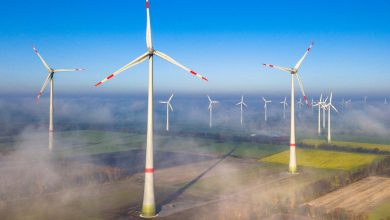Challenges of the clean energy transition

by Judith Curry
This morning I participated Conference on Energy and Decarbonization – A New Jersey Business Perspective. https://njbia.regfox.com/energy-summit.
UPDATE: full recording of the conference [here]
New Jersey is a leader among U.S. states in aggressively tackling the transition to cleaner sources of energy (see the New Jersey Energy Master Plan). So far, they have been doing a better job than California. The near term challenges of the transition to clean energy are described in this article in the City Journal
New Jersey has a pretty good mix of electricity generation sources: 57.2% natural gas, 37.4% nuclear, 1.6% solar, 1.5% coal, 1.1% biomass, 0.9% non-biogenic waste, and 0.1% hydroelectric & wind.New Jersey’s renewable portfolio standard was updated in 2018 to require that 21% of electricity be from renewable sources by 2021, 35% by 2025, and 50% by 2030.
This Conference was a pretty interesting event. Here is the agenda and list of speakers:
- Opening Remarks: Ray Cantor, Vice President, Government Affairs, New Jersey Business & IndustryAssociation
- The Murphy Administration: Joseph L. Fiordaliso, President, Board of Public Utilities and Shawn M.LaTourette, Commissioner, Department of Environmental Protection
- Climate Risks and Energy Policy Options: Dr. Judith Curry, President, Climate ForecastApplications Network
- Energy Demand: Dr. Prasanna V. Joshi, Senior Manager of Corporate Strategic Research, ExxonMobil
- Reliability Concerns: Elliott Nethercutt, National Regulatory Institute, NARUC
- Transmission Infrastructure: Bob Martin, Managing Director, Christie 55 Solutions
- Costs of Decarbonization: Dan Shreve, Head of Global Wind Energy Research, Wood MacKenzie
- Offshore Wind: Kris Ohleth, Executive Director, Special Initiative on Offshore Wind
- The Role of Gas Infrastructure in the Clean Energy Economy: Steve Westhoven, CEO, NewJersey Resources
- Nuclear: Rick Thigpen, Senior Vice President for Corporate Citizenship and PSEG Foundation Chair atPublic Service Enterprise Group (PSE&G)
- Solar: Jim Spano, Managing Partner, Spano Partners
- Heavy Duty Transportation: Dawn Fenton, Vice President for Government Relations and PublicAffairs, Volvo Group North America
- Labor Concerns and Workforce: Kate Gibbs, Deputy Director, ELEC 825
- Challenges for Buildings: Joe Uglietto, President, Diversified Energy Specialists (DES)
The State administration of NJ assumes that climate change is a code red emergency. Industry leaders and people in the electricity sector are more concerned about energy reliability and cost, arguing for a slower transition. This Conference promoted dialogue among a range of leaders and stakeholders.
I was asked to update the audience on the latest IPCC assessment, topics of specific relevance to New Jersey, and the implications for the clean energy transition.
The slides for me presentation are here (hopefully you can download it?)
Some of the slides I’ve used before, but are included here again for completeness. My verbal remarks are provided below:
Slide 2 IPCC
The climate crisis can be summarized as:
- Its warming
- The warming is caused by us
- Warming is dangerous
- We need to urgently transition to renewable energy to stop the warming
- Once we stop burning fossil fuels, sea level rise will stop and the weather won’t be so extreme
Last August, the Intergovernmental Panel on Climate Change, or IPCC, issued its 6th Assessment report. In response, the secretary general of the UN stated that
“This is code red for humanity.”
Slide 3 what’s wrong with this narrative
In my talk today, I’m going to present you with a different perspective on the climate change problem and how we can approach solutions.
So what’s wrong with the crisis narrative? It is my assessment that
- We’ve vastly oversimplified both the problem and its solutions
- The complexity and uncertainty surrounding climate change is being kept away from the public and policy debates.
- Rapid reductions in emissions are technologically and politically infeasible on a global scale, with adverse negative consequences.
- And finally, the climate crisis narrative gets in the way of real solutions to our problems
Slide 4 97% consensus
Even people that don’t know much about climate science have heard that 97% of climate scientists agree. But exactly what do they agree on? Not nearly as much as portrayed by the media. Everyone agrees that:
- Surface temperatures have increased since 1880
- Humans are adding carbon dioxide to the atmosphere, and
- Carbon Dioxide and other greenhouse gases have a warming effect on the planet
However, there is uncertainty and disagreement on the most consequential issues:
- How much of the recent warming has been caused by emissions
- How much the planet will warm in the 21st century
- Whether warming is ‘dangerous’
- And how we should respond to the warming, to improve human well being
Slide 5 21st century warming
For policy making, the most consequential issue is how much warming we can expect in the 21st century. This figure from the latest IPCC report shows climate model projections of global surface temperature anomalies over the 21st century. There’s a large range of warming shown in this diagram, from 3 degrees to 8 degrees Fahrenheit above pre-industrial temperatures. We’ve already warmed by more than 2 degrees Fahrenheit. So whether the future warming is on the low or high end has huge implications for climate policy. The largest amount of warming is associated with an extreme emissions scenario, SSP-8.5, shown by the purple curve.
The large amount of uncertainty in 21st century projections of surface temperature is associated with:
- The amount of emissions
- The sensitivity of the climate to these emissions
- And finally, there is substantial uncertainty about the relative importance of natural climate variability.
Slide 6 Emissions scenarios
On the previous slide, recall that the largest amount of warming was associated with the emissions scenario SSP-8.5. The IPCC 5th Assessment Report regarded the 8.5 scenario to be our most likely future, and it was referred to as the business-as-usual scenario.
However, it’s becoming increasingly apparent that the 8.5 scenarios are implausibly high, if not impossible. The gray lines show emissions projections made by the International Energy Agency out to 2050. The IEA projections show fairly steady emissions through 2050, that are much lower than the 8.5 scenarios. The IEA projections are even somewhat lower than the IPCC’s medium emissions scenario, SSP-4.5.
Nevertheless, the most recent IPCC report emphasizes the 8.5 scenario. Not surprisingly, this extreme emissions scenario is the source of alarming impacts.
—-
The second major source of uncertainty is the sensitivity of the global temperatures to a doubling of carbon dioxide. For decades, the likely range for climate sensitivity has been between 1.5 and 4.5 degrees centigrade, which is reflected by the assessment from the IPCC AR5 published in 2013.
The red bars in this figure shows the range of climate sensitivity from the most recent climate model simulations, ranging from 1.8 to 5.7 degrees. These values are overall much higher than those from the AR5, whose highest value was 4.6 degrees.
In spite of the larger range from the climate models, the most recent IPCC AR6 substantially narrowed the likely range of climate sensitivity to between 2.5 and 4 degrees, indicated by the vertical blue lines, rejecting the highest values from the climate models. However this narrowing of the range is disputed, particularly on the low end. The whole issue of climate sensitivity to increasing carbon dioxide remains unsettled.
The bottom line here is some good news. The extreme tail risks from global warming, associated with very high emissions and high climate sensitivity, have shrunk and are now regarded as implausible.
Slide 7 RCP4.5
So, what is our best estimate of the amount of warming expected in the 21st century? The closest emissions scenario to the projections from the International Energy Agency is the medium emissions scenario, SSP4.5.
The recent IPCC report provides ‘constrained’ projections, that includes only the climate models with values of climate sensitivity between 2.5 and 4 degrees Centigrade. The IPCC’s best estimate for warming by 2100 is 4.9 degrees Fahrenheit, relative to a preindustrial baseline for the period 1850-1900. The policy relevant targets of 1.5 and 2 degrees centigrade, indicated by the dashed lines, reflect temperature change relative to this preindustrial period. We have already warmed 1.3 degrees Centigrade, or 2.3 degrees Fahrenheit. The IPCC’s best estimate has us crossing the 1.5 degree threshold in about 2030, and the 2 degree threshold in about 2055.
There are numerous reasons to expect that the amount of warming will be lower than the IPCC’s best estimate. The current emissions trajectory is running below the 4.5 scenario. Lower values of climate sensitivity would also delay crossing these thresholds. The other factor to consider is natural climate variability. Major volcanic eruptions would have a cooling effect. A solar minimum is expected in the 21st century, following the grand solar maximum that occurred in the late 20th century. Natural variability associated with the large-scale ocean circulations is also expected to contribute to cooling in the coming decades.
We need to recognize that how the climate of the 21st century will play out is a topic of deep uncertainty. Once natural climate variability is accounted for, it may turn out to be relatively benign. Or we may be faced with unanticipated surprises.
Slide 8 Is warming dangerous
The next area of disagreement takes us away from science and into the realm of values. How dangerous is global warming? The IPCC 5th Assessment Report used a burning embers diagram to portray reasons for concern. The level of concern increases with the amount of global warming. Note that the IPCC does not use the words ‘dangerous’, ‘crisis’ or ‘catastrophe’ in its reports; rather it refers to ‘reasons for concern.’
Any evaluation of dangerous climate change must confront the Goldilocks principle. Exactly which climate state is too hot versus too cold? Some answer this question by stating that the climate we’re adapted to is ‘just right’. However, the IPCC refers to a preindustrial baseline, in the late 1700’s. Why anyone thinks that this is an ideal climate is beyond me. This was during the Little Ice Age, the coldest period of the millennia. Think George Washington and the horrible winters at Valley Forge.
While the categories of concern in the burning embers diagram seem a bit nebulous, the 6th assessment report focused on extreme weather and climate events. Lets take a look.
Slide 8 New normal
The recent IPCC report identified an increase in the intensity and frequency of heat waves, but a decrease in cold waves. The decrease in cold events is actually very good news. Numerous studies have found that there are more deaths from cold events than from heat events, by as much as an order of magnitude.
The recent IPCC report also identified an increase in the frequency and intensity of heavy rain events. The IPCC looked at the period since 1950 in assessing trends in extreme events. However, looking only at the record since 1950 can lead to weather amnesia.
New Jersey is facing the prospect of increased flooding. New Jersey is rightfully concerned about impacts from hurricanes. But these impacts are not necessarily worsening as a result of global warming. The worst hurricane to strike New Jersey in the historical record occurred in 1821 – a category 4 hurricane with a 13 foot storm surge.
Hurricane Ida recently caused 7 inches of rain in New Jersey over 2 days. How does this compare with the historical record? Central Park in New York City has a data record that goes back to the 1860’s. The highest daily rainfall accumulation occurred during 1883, over 8 inches.
Looking at the historical data of extreme weather events helps us avoid weather amnesia. Further, it reminds us that even worse extreme weather events have occurred in the historical record, and that elimination of fossil fuel emissions isn’t going to prevent extreme weather events.
Slide 10 hurricanes
The recent IPCC report concluded that it’s likely that the global proportion of major hurricanes (which are category 3 and higher) has increased over the last four decades. However, the actual number of major hurricanes does not show a meaningful trend that can be distinguished from natural variability.
The left-hand diagram shows the number of major hurricanes that have made U.S. landfall since 1900. The year 2005 stands out as the highest, which was followed by a period of 11 years with no major hurricane landfalls. Also, there were a large number of major hurricane landfalls during the first half of the 20th century, when surface temperatures were significantly cooler.
The large amount of natural variability makes it difficult to identify meaningful trends in hurricane activity, and even more difficult to attribute any trend to manmade global warming.
Slide 11 NJ SLR
Sea level rise is an unambiguous impact of global warming. This figure shows the sea level data record for Atlantic City. Since 1910, sea level has been rising at a steady rate of 1.36 feet, or 16 inches, per century. New Jersey’s coastal sea level rise is somewhat larger than the global average, owing to local sinking from geological processes and extraction of ground water.
In 2019, a team of scientists led by Rutgers University prepared a report entitled “New Jersey’s Rising Seas and Changing Coastal Storms.” By 2100, for the medium emissions scenario, the Rutgers report predicted a likely range of sea level rise to be between 2 and 5.1 feet. New Jersey’s plan for Protecting Against Climate Threats, or PACT, adopted 5.1 feet as the basis for its regulations.
Slide 12 Rutgers
In January 2021, I was contacted by Ray Cantor of the New Jersey Business and Industry Association, to provide an independent evaluation of the projections in the Rutgers Report.
The main conclusion of my report was that the Rutgers projections are substantially higher than the IPCC projections, owing to their method of incorporating extreme scenarios of instability in the West Antarctic Ice Sheet.
Slide 13 Global sea level rise
This figure is from the most recent IPCC Report. The left column shows projections of global mean sea level to 2050, and the right column shows projections to 2100. The middle row, circled in red, shows projections for the medium emissions scenario. Looking at the 2100 projections, the yellow bar indicates the likely range from the latest IPCC report, with an upper value of 2.5 feet. Accounting for local effects for New Jersey produces a value of 3.1 feet.
This value of 3.1 feet is substantially lower than the 5.1 feet cited in the Rutgers Report. The latest IPCC report reinforces my previous assessment that the sea level rise projections from the Rutgers report are far too high.
Slide 14 Adapting
In evaluating the dangers of climate change, it’s important to assess how global societies have dealt with the warming that we’ve already seen. So far, the world has done a decent job at adapting to weather extremes and climate change. The upper left figure shows the change in yield for major crops, with yields for many crops doubling or even quadrupling since 1960.
The figure in the lower left shows losses from global weather disasters as a percent of GDP. The spikes are associated with years that showed large losses from tropical cyclones. Overall for the past 30 years, there has actually been a slight decline in losses.
The diagram in the lower right shows the number of deaths per million people from weather and climate catastrophes. Over the past century, climate related deaths have dropped by 97%.
Slide 15 IEA
Under the auspices of the United Nations, the world is attempting to reach netzero in carbon emissions by 2050.
This diagram from the International Energy Agency illustrates the challenge. The blue curve shows expected emissions based on policies that are currently in place. The yellow curve shows the pledges that countries have made as part of the Paris Agreement. And the green curve shows the path we should be on to reach netzero by 2050.
There’s a large gap between our current and committed policies versus the netzero target. There are numerous impediments to reaching netzero: waiting for better technologies, costs of the transition, and politics surrounding natural gas and nuclear energy. But most importantly, there are concerns about maintaining energy security during the transition, in terms of electricity reliability and cost.
Slide 16 Netzero
The path to net zero by 2050 is generally regarded to consist of the following elements:
- The fundamental premise is to eliminate fossil fuels
- Then replace fossil fuel generation with clean energy, focusing on solar, wind, biofuels.
- Nuclear energy remains controversial, although there is a recent surge of support in Europe and Japan.
- There’s an implication of austerity in terms of using less energy
- In doing the carbon accounting, it is very difficult to achieve netzero by 2050 without carbon capture and storage. However, we do not currently have the capability to accomplish this at anything close to the needed scale.
The International Energy Agency finds that there is a possible but very narrow pathway to netzero by 2050, provided that there’s a huge leap in energy innovation and major efforts to build new infrastructure. Other analysts find that reaching netzero globally by 2050 is a social and technological impossibility.
Slide 17 netzero problems
Some countries and states can reach netzero by 2050 relatively easily if they have a large amount of hydropower or an existing base of nuclear power. However, it will be very difficult for most other regions, particularly in the face of growing population and desired economic growth.
But even if we can’t meet the targets, we should try anyways, right?
Well, the fundamental problem is the level of urgency. I’ve shown that the perception of a crisis and the level of alarm that is often portrayed in the media and by politicians is overblown. Targets that are too stringent lead to decisions that aren’t beneficial in the longer term.
Another key issue is that the demand for electricity is growing. We need much more electricity, not less. Going on an energy diet like we did in the 1970’s is off the table. We don’t just want to survive, we want to thrive. We need more electricity to support innovation and thrivability in the 21st century.
Slide 18 robustness
A more pragmatic approach to dealing with climate change drops the timelines and emissions targets, in favor of accelerating energy innovation.
Once the stringent targets are removed, you have space to imagine what the infrastructure for our 21st century electricity system could look like, with new technologies for electricity generation and a 21st century transmission infrastructure that is more resilient to extreme weather events.
Compare this vision against the current plan for urgently implementing 20th century wind and solar technologies, patching them into the existing transmission grid, eliminating backup power sources of natural gas and nuclear, and then hoping for the best. This is where urgently working towards NETZERO by overinvesting in wind and solar is leading us.
Nations and states are coming to grips with their over dependence on wind and solar, notably California, the UK and Europe. In 2021 so far, offshore wind in the North Sea has provided 7% of the UK electricity, compared to 25% in 2020. Concerns about not meeting electricity needs next winter are resulting in a near term reliance on coal in Europe and Asia.
You can avoid this situation by hanging on to your existing nuclear and natural gas generating capacity. Nuclear and natural gas are key enablers for reducing carbon emissions today in the near term. Natural gas is essential for keeping energy prices in check while we invest in the technology and infrastructure necessary to attain net zero in the future.
We can be sure the future of the 2030’s will look very different from the future of today. In evaluating clean energy technologies, extend your horizon to the 2030’s and build in the capability to adopt new technologies in your planning process.
Consideration of these factors can lead to a better and even cleaner electricity system by mid century, including new technologies, such as small modular nuclear reactors and advanced geothermal.
Slide 20 thank you
The Energy Transition will be one of the most capital- and resource- intensive undertakings in the history of mankind. It is essential for business and industry to provide a reality check on both technical feasibility and economic realities.
But more importantly, we need to change the focus of conversation, and here is where business leaders can take charge. Focus on a 21st century vision for electric power infrastructure, with abundant, cheap and clean electricity. Sell prosperity and thrivability as the motivations for this. Support innovation. Not greenwashing, which the energy industry is often accused, but come up with a real plan. Its time to listen to business and the engineers, not the politicians and activists. Come up with a good plan, and even the climate activists will have a hard time objecting.




